In this Feb. 1, 2016 photo released by The Marine Mammal Center, Moâo, an endangered Hawaiian monk seal, participates in rehab after being rescued and admitted to the Marine Mammal Centerâs Big Island seal hospital in Kailua-Kona, Hawaii. Seven seals were found either abandoned or malnourished and were rescued by federal officials and then rehabilitated at the marine hospital in Hawaii. The Coast Guard picked them up and flew them back to Honolulu Thursday, April 14, 2016 for the first leg of their trip back to their native Northwestern Hawaiian Islands. (Julie Steelman /The Marine Mammal Center via AP)
The Associated Press
ABOARD US COAST GUARD HC-130 HERCULES (AP) - A U.S. Coast Guard airplane rumbled down an airstrip on Hawaii's Big Island, carrying hundreds of pounds of rare and precious cargo: seven endangered Hawaiian monk seals.
Federal officials found most of the young animals malnourished late last year in the uninhabited Northwestern Hawaiian Islands, the northernmost islands and atolls in the Hawaiian Islands chain.
The National Oceanic and Atmospheric Administration brought the seals to the nonprofit Marine Mammal Center on the Big Island, which nursed them back to health.
Now rehabilitated, they have started their journey home.
The Coast Guard loaded the seals on a HC-130 Hercules plane Thursday and flew them to Honolulu. The Associated Press was on the flight.
The animals will stay in a NOAA facility on Oahu until they embark on a roughly weeklong journey by boat back to their home islands. One will return to the privately owned island of Niihau.
Monk seals number only about 1,200 worldwide, and they all live in the main or Northwestern Hawaiian Islands, federal officials said.
Fewer than one in five survive their first year in the uninhabited islands because of threats including predation, entanglement and environmental changes, according to the California-based Marine Mammal Center.
All those being transported Thursday were female, said Michelle Barbieri, a NOAA veterinarian with the Monk Seal Research Program who was aboard the flight.
"We focus our efforts on female seals because they're going to grow up and contribute to the population in the future," Barbieri said.
While in rehab, the seals were nursed to a healthy weight to help increase their odds of survival, initially receiving fish mash through a feeding tube. They later were taught to catch and eat fish, with little human intervention, so they can hunt for themselves when they return to the wild.
"We don't want them to become habituated to people or associate food with people," Shawn Johnson, director of veterinarian science for the Marine Mammal Center, said in a telephone interview Friday. "So we can't go out there and hand-feed them."
He said he hopes the center can reintroduce 10 to 15 seals per year, which could have a dramatic effect on the population in years to come. The facility has successfully released eight seals so far, but this group was its biggest recovery and release effort to date.
Eric Roberts, a Coast Guard marine mammal response coordinator, helped bring the pups to the hospital and was there to escort them home.
"At the Coast Guard, we pride ourselves on being lifesavers, and this is a unique opportunity where we can actually contribute to saving a species," Roberts said.
Rescuers normally transport only one or two seals at a time, making Thursday's effort "historic" and a major boost for the overall population, which is declining by about 4 percent per year, said David Scholfield, a NOAA response coordinator for the Pacific Islands.
"These seven animals would have died," Scholfield said. "So getting them back to health and having them potentially reproduce in the wild, and produce offspring, has a many magnitude effect."
All seals that are released are equipped with tags so scientists can monitor their health, Johnson said.
___
Follow Caleb Jones on Twitter: https://twitter.com/CalebAP . His work can be found at http://bigstory.ap.org/journalist/caleb-jones .
Kevin Deininger, a United States Coast Guard loadmaster, smiles at one of seven endangered Hawaiian monk seals that were being transported from Hawaiiâs Big Island to Honolulu, Thursday, April 14, 2016 in Kailua-Kona, Hawaii. The seven seal pups were found either abandoned or malnourished and were rescued by federal officials and then rehabilitated at a marine mammal hospital on the Big Island. The Coast Guard picked them up and flew them back Honolulu Thursday for the first leg of their trip back to their native Northwestern Hawaiian Islands. (AP Photo/Caleb Jones)
The Associated Press
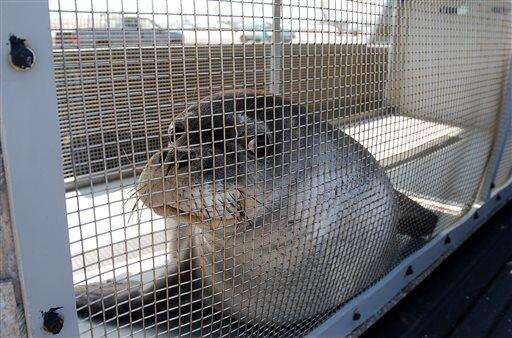
ADDS MONK SEAL TO THE SUBJECT - An endangered Hawaiian monk seal looks out from her container as she is transported from Hawaiiâs Big Island to Honolulu, Thursday, April 14, 2016, in Kailua-Kona, Hawaii. Seven seal were found either abandoned or malnourished and were rescued by federal officials and then rehabilitated at a marine mammal hospital on the Big Island. The Coast Guard picked them up and flew them back to Honolulu Thursday for the first leg of their trip back to their native Northwestern Hawaiian Islands. (AP Photo/Caleb Jones)
The Associated Press
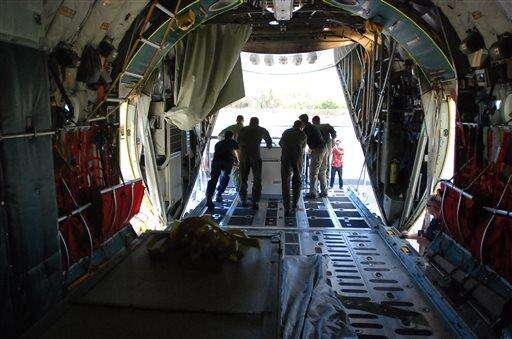
Coast Guard and NOAA officials unload an endangered Hawaiian monk seal after a flight from Kailua Kona, Hawaii to Honolulu, Thursday, April 14, 2016. Seven endangered Hawaiian monk seals that were found abandoned or malnourished have begun their trip back to their remote island homes after being rescued and rehabilitated. The National Oceanic and Atmospheric Administration rescued the seal pups several months ago on the Northwestern Hawaiian Islands, the northernmost islands and atolls in the Hawaiian Islands chain. The nonprofit Marine Mammal Center's monk seal hospital on Hawaii's Big Island then nursed them back to health. (AP Photo/Caleb Jones)
The Associated Press
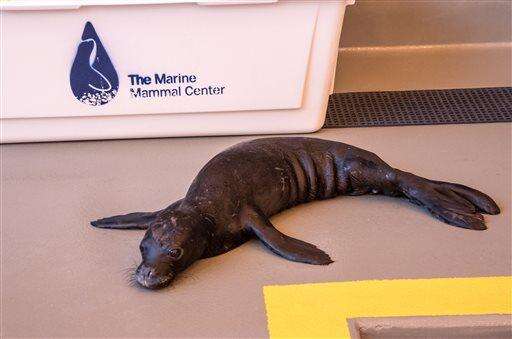
In this Sept. 8, 2015 photo released by The Marine Mammal Center, Kilo, an endangered Hawaiian monk seal, rests after being rescued and admitted to the Marine Mammal Centerâs Big Island seal hospital in Kailua-Kona, Hawaii. Seven seals were found either abandoned or malnourished and were rescued by federal officials and then rehabilitated at the marine hospital in Hawaii. The Coast Guard picked them up and flew them back to Honolulu Thursday, April 14, 2016 for the first leg of their trip back to their native Northwestern Hawaiian Islands. (Julie Steelman /The Marine Mammal Center via AP)
The Associated Press
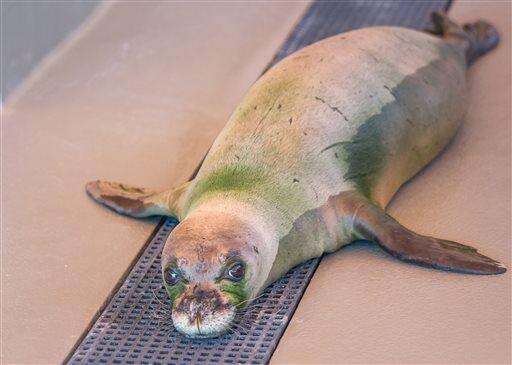
In this Nov. 7, 2015 photo, Moâo, an endangered Hawaiian monk seal, rests after being rescued and admitted to the Marine Mammal Centerâs Big Island seal hospital in Kailua-Kona, Hawaii. Seven seals were found either abandoned or malnourished and were rescued by federal officials and then rehabilitated at the marine hospital. The Coast Guard picked them up and flew them back to Honolulu Thursday, April 14, 2016 for the first leg of their trip back to their native Northwestern Hawaiian Islands. (The Marine Mammal Center, Julie Steelman via AP)
The Associated Press

A Coast Guard HC-130 Hercules is prepared for takeoff, Thursday April 14, 2016 in Honolulu. Seven endangered Hawaiian monk seals that were found abandoned or malnourished late last year began their trip back to their remote island homes Thursday after being rescued and rehabilitated. The National Oceanic and Atmospheric Administration found most of the seal pups on the Northwestern Hawaiian Islands, the northernmost islands and atolls in the Hawaiian Islands chain. The nonprofit Marine Mammal Centerâs monk seal hospital on Hawaiiâs Big Island then nursed the animals back to health. (AP Photo/Caleb Jones)
The Associated Press
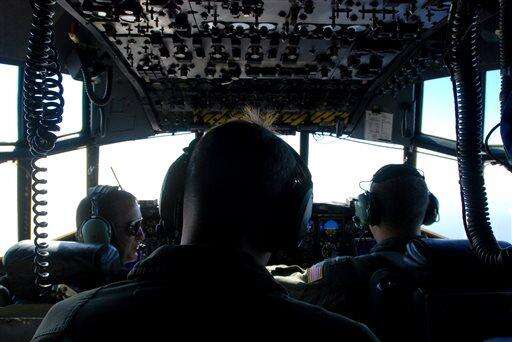
U.S. Coast Guard pilot Lt. Eric Casida, left, and co-pilot Lt. j.g. Kevin Knaup, right, fly a HC-130 Hercules from Honolulu to Kailua-Kona, Hawaii, Thursday, April 14, 2016. The crew was transporting seven endangered Hawaiian monk seals back to Honolulu. The seals were found either abandoned or malnourished and were rescued by federal officials and then rehabilitated at a marine mammal hospital on the Big Island. The Coast Guard picked them up and flew them back to Honolulu Thursday for the first leg of their trip back to their native Northwestern Hawaiian Islands. (AP Photo/Caleb Jones)
The Associated Press

An endangered Hawaiian monk seal looks out from her container as she is transported from Hawaiiâs Big Island to Honolulu, Thursday, April 14, 2016, in Kailua-Kona, Hawaii. Seven seal were found either abandoned or malnourished and were rescued by federal officials and then rehabilitated at a marine mammal hospital on the Big Island. The Coast Guard picked them up and flew them back to Honolulu on Thursday for the first leg of their trip back to their native Northwestern Hawaiian Islands. (AP Photo/Caleb Jones)
The Associated Press
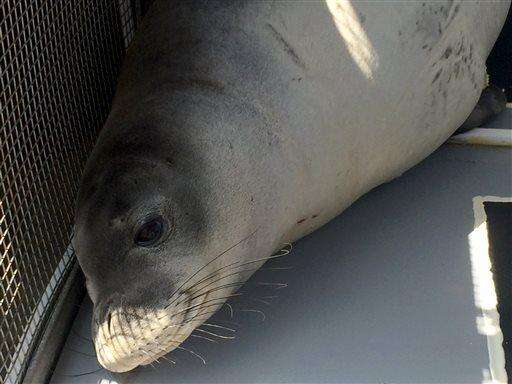
An endangered Hawaiian monk seal looks out from her container as she is transported from Hawaiiâs Big Island to Honolulu, Thursday, April 14, 2016, in Kailua-Kona, Hawaii. Seven seal were found either abandoned or malnourished and were rescued by federal officials and then rehabilitated at a marine mammal hospital on the Big Island. The Coast Guard picked them up and flew them back to Honolulu on Thursday for the first leg of their trip back to their native Northwestern Hawaiian Islands. (AP Photo/Caleb Jones)
The Associated Press
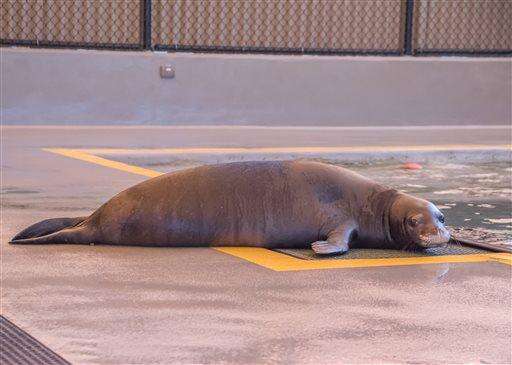
In this April 11, 2016 photo, Kilo, an endangered Hawaiian monk seal, lays next to a poll after being treated at the Marine Mammal Centerâs Big Island seal hospital in Kailua-Kona, Hawaii. Seven seals were found either abandoned or malnourished and were rescued by federal officials and then rehabilitated at the marine hospital. The Coast Guard picked them up and flew them back to Honolulu Thursday, April 14, 2016 for the first leg of their trip back to their native Northwestern Hawaiian Islands. (The Marine Mammal Center, Julie Steelman via AP)
The Associated Press

In this March 21, 2016. photo, Puka, an endangered Hawaiian monk seal, rests after being treated at the Marine Mammal Centerâs Big Island seal hospital in Kailua-Kona, Hawaii.Seven seals were found either abandoned or malnourished and were rescued by federal officials and then rehabilitated at the marine hospital. The Coast Guard picked them up and flew them back to Honolulu Thursday, April 14, 2016 for the first leg of their trip back to their native Northwestern Hawaiian Islands. (The Marine Mammal Center, Julie Steelman via AP)
The Associated Press